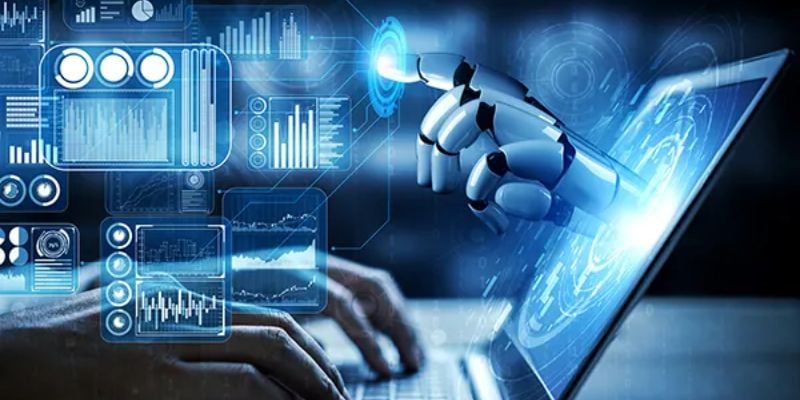The year is just beginning, and the business landscape of 2024 is likely to change due to the powerful combination of disruptive forces. Generative AI's enlightening power and ability to solve problems will reveal hidden efficiency.
Now more than a euphemism, sustainability will be an essential aspect of strategic planning, specifically when creating AI models. Quantum computing, previously a fanciful idea from science fiction, can open the doors to previously impossible possibilities.
The world was transformed into a digital world in the past. According to McKinsey, 2023 was the year that saw the emergence of technology. Generative AI is among the technological advancements that contributed to the revival. This new technology, based on AI and machine-learning applications, has the potential to impact various sectors.
In 2022, investment in the latest technologies, like applications of AI advanced connectivity, cloud computing, and edge computing, has decreased in the past few years as they've become more sophisticated. Digital identity and trust systems are among the new trends for 2024. Quantum technologies, including quantum, have enormous potential for creating benefits in the coming years.
Internet of Things (IoT)
The Internet of Things (IoT) is witnessing an immense development of its network. In 2024, it will change the way devices communicate and connect. It's not just limited to the sheer quantity of connected devices but also expands to various industries and applications using IoT technologies.
The most prominent features of the IoT change are the rapid advancement of smart homes and the growth of connected devices in homes, ranging from smart thermostats and lights to security cameras and voice-activated assistants.
Integrating IoT in homes can improve efficiency, convenience, and security. The connectivity of these devices allows for an automated and integrated living space in which residents can be in control and supervise all aspects of their home from a distance.
Beyond the residential zones, IoT is making profound advancements in healthcare, agriculture, and industry. IoT devices used in the healthcare industry include wearable fitness trackers and remote monitoring tools for patients, which can be used to create active healthcare management systems that can provide quick intervention.
In agriculture, IoT-driven precision farming practices, which include sensors, analytics, or even sensor technology, could increase crop yield, monitor soil conditions, and efficiently manage resources. Industries are adopting IoT to streamline maintenance processes, monitor equipment in real-time, and optimize supply chains, which leads to increased efficiency of operations and lower expenses.
To address these security issues, theIoT app development companycreates solutions to improve security within the IoT world. Integrating blockchain technology to safe and secure data transactions, introducing access control, and developing security frameworks is a good idea. =
Collaboration between all parties involved, including device makers, service providers, and regulatory authorities, is essential to establishing comprehensive security standards and ensuring the appropriate implementation and use of IoT technologies.
5G Technology
The arrival of 5G technology could begin a new period in connectivity and communications. The introduction and use of the 5G network will change the connectivity landscape in 2024. Telecom companies worldwide are focusing on the advent of 5G networks to ensure they will provide faster and more secure internet connections.
The impact of 5G on technology, connectivity, and communications is profound. With its much more efficient data transfer speed and lower frequency, 5G's network will enable seamless interaction, live communications, high-quality video conferences, and ultra-responsive applications.
The greater connectivity will affect both businesses and individuals, which provides new possibilities to collaborate remotely and work from home with the rapid expansion of high-end digital services.
One of the significant benefits of 5G will be the world of mobile user experience. 5G's adoption will bring enhanced mobile experiences, offering speedier download and upload speeds, smoother streaming, and improved quality overall experience for mobile applications.
Users can expect to engage via AR and VR (AR) and Virtual Reality and the virtual world (VR),as well as an enhanced experience of multimedia content that is sharp and speedy, which will elevate the overall experience for mobile users to a new level.
The impact of 5G goes beyond traditional communication and communications towards the Internet of Things (IoT) and autonomous cars. The high-speed, low-latency characteristics of 5G network networks are crucial to support the massive connectivity requirements for IoT devices.
This allows for various applications, from smart cities with connected sensors to large-scale industrial IoT deployments that improve processes and resources. In the era of connected vehicles, 5G plays a crucial function in facilitating real-time communications between vehicles, traffic infrastructure, and cloud-based services, improving the safety and effectiveness of transport systems.
However, the massive implementation of 5G has its challenges and concerns, including the need to build and expand existing infrastructures, coordinate spectrum, and deal with health issues that could emerge. Implementing 5G infrastructure requires significant investments in enhancing existing networks and adopting new technologies, which opens up opportunities and challenges for telecommunications firms and regulatory bodies.
Artificial Intelligence and Machine Learning
Artificial Intelligence (AI) and machine learning (ML) will experience rapid growth and advancement by 2024, driving significant advances in various sectors. AI's continuous development changes how we interact with and work with technology. One of the main trends is the continual advancement of AI capabilities, as shown by the advancements in deep learning nat, natural language processing, and even computer vision.
Integrating AI into our daily lives is now more common than ever. From personal assistants, which are activated using voice commands, to smart home devices and recommendation algorithms for streaming apps, AI has seamlessly woven into our daily routines. The simplicity of use and efficiency developed by AI-based development company aid in creating an ever-more connected and automated lifestyle.
In the field of Machine Learning, there's a rise in the use of innovative techniques that go beyond traditional supervised models. Unsupervised and reinforcement learning are gaining more attention, allowing systems to learn and adapt without explicit programming. This allows for more complex problems, enabling machines to make decisions based on feedback and experiences.
AI-driven technologies have a massive impact on every industry, changing processes and increasing productivity. AI analyzes medical images, drug discovery, and personalized healthcare treatment plans.
Finance companies benefit from using AI to identify fraud and control risk in trading and algorithms. Manufacturing and logistics utilize AI to improve predictive maintenance and optimize production processes in the supply chain. The variety of AI applications shows its transformative potential in various areas.
In addition, AI can help develop intelligent cities. AI algorithms can optimize traffic flow, regulate energy consumption, and improve public services. The agriculture sector is experiencing the advantages of AI, which could improve farming methods, boost crop yield, and optimize resource use. Educational systems utilize AI to design individual learning experiences tailored to students' needs.
As AI becomes more sophisticated, ethical issues regarding AI methods become more commonplace. Beliefs in the bias of algorithms in data privacy and the effects on society from AI technology have created discussions about the ethics of AI and the development of advanced AI tools.
Augmented Reality (AR) and Virtual Reality (VR)
Augmented and Virtual Reality will see technological advances in 2024, transforming how we interact with physical and virtual environments. AR and VR technology has revolutionized our interactions. Their technological advancements have extended the boundaries of what was believed to be achievable and opened up new opportunities across a variety of sectors.
AR and VR technological advances are highlighted by hardware capabilities, enhanced graphics rendering, and the integration of more sophisticated sensors. These advancements provide more immersive and realistic experiences that make it possible to bridge the gap between the virtual and real worlds. The improved technology of AR and VR equipment, including high-end and lightweight headsets, makes this technology accessible to a broader audience.
AR, VR, and VR bring significant gaming, education, and medical advancements. VR technology gives gamers an immersive experience in real-time, while AR enhances gaming by overlaying digital elements into actual life. AR and VR have revolutionized the way education is taught through interactive and enjoyable simulations such as virtual field trips and three-dimensional educational materials.
Healthcare software development can use these emerging technologies by allowing models of medical training, virtual surgeries, and applications for rehabilitation that utilize VR to treat pain and improve rehabilitation.
Mixed-reality experiences combine elements of VR and AR and are quickly gaining popularity. The convergence allows users to interact with digital and physical elements simultaneously, blurring the lines between the real and the virtual.
Mixed Reality has become a trendy technology used in classrooms, where users can manipulate digital objects in a live environment, improving their abilities and enhancing learning.
AR, VR, and AR are becoming more popular in the business world. They provide new remote collaboration methods and increase productivity. Businesses use AR to make dynamic presentations, virtual meetings, and remote assistance, while VR provides realistic simulations for training and annual conferences.
Incorporating AR and VR in the business process helps create a new era of remote collaboration, removing geographical barriers while delivering exciting and interactive communication tools.
Quantum Computing
Quantum Computing stands at the cutting edge of technological advancement and advances research that leads to revolutionary advances. By 2024, Quantum Computing will be an enthralling issue. Quantum Computing is witnessing an explosion of innovations that could transform the way we see it.
Researchers and scientists have made substantial progress in quantum computing, overcoming challenges regarding qubit stability, accuracy correction, and scaling. The advancement of quantum algorithms can enhance Quantum computers' capabilities and offer solutions to complex problems that are not possible with conventional computers.
This trend is highlighted by the advancement of quantum processors and the rising popularity of quantum supremacy, which means quantum computers outperform conventional computers for specific tasks.
The practical applications of Quantum Computing are becoming more accurate. However, there are challenges to overcome. Quantum computers can address problems related to optimization, cryptography, and the modeling of quantum systems.
However, the technology faces issues such as the potential vulnerability of quantum bits (qubits) to interference from external sources and the need for error correction techniques. Researchers are working on solving these issues to make the full potential for quantum computing real-world applications.
The impact quantum computing can have on Quantum Computing in industries is essential. In finance, quantum-based techniques will change how we handle the risk of portfolio management, risk reduction, and financial modeling.
In drug discovery and material science, quantum computation will simulate molecular and atomic interactions with incredible accuracy, which could speed up the development of new drugs and materials. Additionally, it will help optimize the supply chain; learning machines and artificial intelligence could profit from quantum computing.
The contrast between quantum computing and classical computing reveals the key differences. While conventional computers use bits of data that can be either one or zero, Quantum computers utilize qubits, which can be in multiple states simultaneously because of the superposition principle and Entanglement.
This is a fundamental characteristic that lets quantum computers handle certain types of data at a much faster rate than traditional computers. Quantum superiority, as proven in certain circumstances, demonstrates the advantages of quantum computers when solving problems that would be difficult for regular computers to tackle within a reasonable amount of time.
Blockchain and Cryptocurrency
Blockchain and Cryptocurrency are undergoing rapid changes in 2024 as new trends are altering how we think about and use decentralized technology. Blockchain, the primary technology that powers Cryptocurrency, is continuously developing, and new ideas are being developed to redefine its use across many industries.
One of the most significant emerging developments in blockchain is the importance of interoperability and scaling. Blockchain networks are working to overcome issues regarding transaction speed and their ability to reach the mainstream through faster and more effective solutions. Interoperability among various blockchain platforms is increasing in popularity, promoting collaboration and interoperability across different blockchain networks.
Cryptocurrencies were previously thought of as outliers in finance but are now gaining mainstream acceptance. Financial institutions and corporations of all sizes have embraced Cryptocurrency, acknowledging its credibility as an asset.
Incorporating Cryptocurrency into the traditional banking system can be seen in introducing financial services based on Cryptocurrency, institutional investments, and most firms' acceptance of digital currency.
NFTs, also known as non-fungible tokens (NFTs),and other digital assets have been deemed crucial and transformative in blockchain technology. NFTs, a distinctive digital token that identifies the ownership of specific items or content, are seeing huge growth in entertainment, arts, and gaming. Creating and exchanging digital currencies through blockchain gives creators new ways to make money from their work and prove ownership. This improves the way we think about and exchange digital media.
Blockchain advancement servicesare creating huge financial advancements, specifically in transforming the conventional process. Blockchain's decentralization and transparency are perfect for financing, allowing faster and more secure transactions.
Furthermore, blockchain is revolutionizing the management of supply chains by providing an untraceable and tamper-proof ledger that guarantees integrity and transparency throughout every step of the supply chain. By controlling delivery, transportation, and product production, blockchain reduces fraud risk and improves effectiveness.
As blockchain technology and Cryptocurrency gain popularity, regulatory concerns and issues are becoming more prevalent. Regulators and government officials are developing guidelines for regulating blockchain technology to ensure that cryptocurrency practices are controlled and address concerns regarding the laundering of money, fraudulent activities, and market stability.
Cybersecurity Trends
In the ever-changing digital world of 2024, cybersecurity has become an essential and constantly evolving field that fights new threats with modern security tools. Technology enhances criminal tactics and leads to the detection of advanced and new security threats.
New cyber security threats pose severe problems for people, custom software development companies, and even the government. Cyberattacks such as ransomware or phishing scams and sophisticated malware continue to increase in sophistication and size. Connectivity and interdependence within our networks create opportunities for cybercriminals' weaknesses in networks, systems, and human behavior.
In addition, with the increase of Internet of Things (IoT) devices, the threat range has increased, which requires proactive measures to guard against data security and privacy dangers.
Cybersecurity is seeing growth in using advanced security solutions to counter these threats. Machine Learning and Artificial Intelligence have increasingly become popular tools in cybersecurity applications to detect and remove security threats quickly.
Prescriptive analytics and behavioral studies can help detect suspicious behavior, protecting against proactive cyber-attacks. Zero-trust security Models, which focus on continuous monitoring of users and devices, can also offer additional security to prevent unauthorized access.
The significance of cybersecurity in the Digital Age must be emphasized. The world is becoming increasingly dependent on digital technology to facilitate commerce, communications, and critical infrastructure; the adverse effects that could be a result of cyber-related security threats to businesses and people are increasing.
Cybersecurity isn't only a matter of technical quality but is also an essential aspect of national security and the economy's stability. Proactive measures, such as solid cybersecurity policies, employee education, and regular security audits, are critical to reducing the chance of cyber-attacks.
Privacy and data security are getting more attention in the current digital age. With the massive volume of personal and sensitive information being processed, gathered, stored, and stored, privacy protection has become an essential security aspect. Regulative frameworks, such as that in the General Data Protection Regulation (GDPR),are designed to permit individuals to control their data and hold organizations accountable for ethical practices in handling data.
Security measures to protect against cyber-attacks, like encryption and secure data storage, are vital to ensure compliance with laws on data protection and the privacy of users.
Sustainable Technology
In the constantly changing digital landscape in 2024, cyber security has become an important and ever-changing field that responds to the latest threats with advanced security tools. As technology improves and becomes more sophisticated, the strategies employed by malicious actors are leading to the identification of more sophisticated and new security threats.
The emergence of cybersecurity threats poses significant dangers for individuals, businesses, and government officials. The threat of ransomware or phishing scams and more sophisticated malware are constantly changing in complexity and size.
The interconnectedness in our systems creates an opportunity for cybercriminals to exploit weaknesses in networks, systems, and human behavior. Furthermore, with the introduction of Internet of Things (IoT) devices, the range of attacks has increased, requiring proactive measures to safeguard against data security and privacy threats.
To fight these threats, the cybersecurity industry is witnessing the rise of Advanced Security Solutions. Artificial Intelligence and machine learning technologies have increasingly become part of cybersecurity tools to detect and quickly counter security risks.
Analytics that can predict behavior and predictive analysis enhance the ability to spot suspicious activities and provide proactive protection against cyber-attacks. Furthermore, Zero Trust Security Models are based on the ongoing checking of devices and users, adding another layer of security that blocks access to users who aren't authorized.
The significance of cybersecurity in the Digital Age should be emphasized. As the world is becoming more dependent on digital technology to communicate, trade, and develop critical infrastructures, the risk of adverse consequences of cyberattacks for businesses and individuals is growing.
Cybersecurity isn't just an issue of quality; it is crucial to the security and stability of the entire nation. Practical measures, like well-designed cybersecurity policies, staff education, and regular security audits, are vital to limit the dangers of cyber-attacks.
Conclusion
The technological landscape in 2024 is an ever-changing mix of accountability and technology. Every new technology is shaping the future where technology seamlessly blends into everyday life, from the continuous advancement of artificial intelligence to excellent quantum computing capabilities.
Despite all this, however, security, ethics, and sustainable practices must be considered. As we navigate the ever-changing world of technology, the responsible use of technology, commitment to cybersecurity, and sustainable technological advances are vital components.
Integrating cutting-edge technologies and ethical considerations will ensure that technology will be an agent of positive change, aiding in tackling global challenges and promoting a fair and sustainable planet. As we take on these incredible technological advancements, a clear and balanced view is necessary to harness technology's power to enhance all people's lives.
FAQs
1. What are the leading tech trends expected to emerge in 2024?
In 2024, various major technological trends will be shaping the future of technology. These include advances in artificial intelligence (AI) as well as the sweeping use of AR and VR, the rise of augmented reality (AR) as well as VR (VR) and the rise in edge computing and the growth of network 5G and the emergence of Internet of Things (IoT) devices, the latest developments in quantum computing technology, rising importance of blockchain technology, and the rapid growth of renewable energy technologies.
2. What will the future of AI (AI) evolve in 2024? (AI) change in 2024?
AI is set to experience significant improvements in 2024, with breakthroughs predicted for deep-learning algorithms, neural processes of language (NLP),and computer vision. AI will be integrated into many industries, changing processes with automated processes, predictive analytics, and personalization of experiences. Ethics-related considerations regarding AI use and regulation will also be more prevalent.
3. What impact will augmented reality (AR) and VR play in 2024? (VR) in 2024?
AR and VR tech are expected to significantly impact areas like gaming, healthcare, education, and manufacturing. The advancement of hardware capabilities and improved tools for creating content and immersive experiences will propel expansion. Businesses will utilize AR/VR for training, product visualization, and remote collaboration, transforming work processes.
4. What will the impact of edge computing be on the technology of 2024?
Edge computing, which processes data close to the source instead of in centrally located data centers, will gain momentum by 2024. This method lowers latency, increases reliability, and improves data security. Applications include autonomous vehicles, IoT devices, and real-time analytics for sectors like finance and retail.
5. What developments can we expect from 5G networks in 2024?
The 5G network will only continue to grow and offer higher speeds, lower latency, and greater capacity. This will lead to new technologies like connected automated vehicles, intelligent cities, and improved mobile experience. 5G infrastructure deployment is expected to accelerate globally, enabling the increasing demand for high bandwidth applications.
6. What do you envision technology like the Internet of Things (IoT) changing by 2024?
IoT devices will be more commonplace by 2024, resulting in the growth of connected homes, smart home devices for healthcare, and automated industrial systems. Enhanced security measures, interoperability standards, and advanced computing capabilities will drive IoT expansion while enabling the seamless exchange of data and connectivity.
7. What are the most anticipated breakthroughs in quantum computing by 2024?
Quantum computing research is expected to advance by 2024, with advances in qubit stability, error-correcting, and quantum algorithmic techniques. Although quantum computers that can be used for general-purpose applications may be a few years off, advances in optimization cryptography, optimization, and material science will be substantial.
8. What will the future of blockchain technology look like by 2024?
Blockchain technology will mature in 2024, bringing increased capacity, interoperability, and acceptance across all industries. Applications will extend beyond cryptocurrency and include managing supply chains, digital identity verification, and financial decentralization (DeFi). The regulatory frameworks and standards will change to take into account blockchain's growing role within the modern economy.










